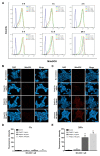Mitochondrial Reactive Oxygen Species in TRIF-Dependent Toll-like Receptor 3 Signaling in Bronchial Epithelial Cells against Viral Infection
- PMID: 38203397
- PMCID: PMC10778811
- DOI: 10.3390/ijms25010226
Mitochondrial Reactive Oxygen Species in TRIF-Dependent Toll-like Receptor 3 Signaling in Bronchial Epithelial Cells against Viral Infection
Abstract
Toll-like receptor 3 (TLR3) plays an important role in double-stranded RNA recognition and triggers the innate immune response by acting as a key receptor against viral infections. Intracellular reactive oxygen species (ROS) are involved in TLR3-induced inflammatory responses during viral infections; however, their relationship with mitochondrial ROS (mtROS) remains largely unknown. In this study, we show that polyinosinic-polycytidylic acid (poly(I:C)), a mimic of viral RNA, induced TLR3-mediated nuclear factor-kappa B (NF-κB) signaling pathway activation and enhanced mtROS generation, leading to inflammatory cytokine production. TLR3-targeted small interfering RNA (siRNA) and Mito-TEMPO inhibited inflammatory cytokine production in poly(I:C)-treated BEAS-2B cells. Poly(I:C) recruited the TLR3 adaptor molecule Toll/IL-1R domain-containing adaptor, inducing IFN (TRIF) and activated NF-κB signaling. Additionally, TLR3-induced mtROS generation suppression and siRNA-mediated TRIF downregulation attenuated mitochondrial antiviral signaling protein (MAVS) degradation. Our findings provide insights into the TLR3-TRIF signaling pathway and MAVS in viral infections, and suggest TLR3-mtROS as a therapeutic target for the treatment of airway inflammatory and viral infectious diseases.
Keywords: TLR3 signaling; bronchial epithelial cells; mitochondria; reactive oxygen species; viral infection.
Conflict of interest statement
The authors declare no conflict of interest.
Figures







Similar articles
-
MUC1 regulates epithelial inflammation and apoptosis by PolyI:C through inhibition of Toll/IL-1 receptor-domain-containing adapter-inducing IFN-β (TRIF) recruitment to Toll-like receptor 3.Am J Respir Cell Mol Biol. 2014 Sep;51(3):446-54. doi: 10.1165/rcmb.2014-0018OC. Am J Respir Cell Mol Biol. 2014. PMID: 24693944 Free PMC article.
-
TRIF-mediated TLR3 and TLR4 signaling is negatively regulated by ADAM15.J Immunol. 2013 Mar 1;190(5):2217-28. doi: 10.4049/jimmunol.1201630. Epub 2013 Jan 30. J Immunol. 2013. PMID: 23365087
-
Toll-like receptor 3-mediated activation of NF-kappaB and IRF3 diverges at Toll-IL-1 receptor domain-containing adapter inducing IFN-beta.Proc Natl Acad Sci U S A. 2004 Mar 9;101(10):3533-8. doi: 10.1073/pnas.0308496101. Epub 2004 Feb 24. Proc Natl Acad Sci U S A. 2004. PMID: 14982987 Free PMC article.
-
Toll-like receptor 3 (TLR3) regulation mechanisms and roles in antiviral innate immune responses.J Zhejiang Univ Sci B. 2021 Aug 15;22(8):609-632. doi: 10.1631/jzus.B2000808. J Zhejiang Univ Sci B. 2021. PMID: 34414698 Free PMC article. Review.
-
TLR3: interferon induction by double-stranded RNA including poly(I:C).Adv Drug Deliv Rev. 2008 Apr 29;60(7):805-12. doi: 10.1016/j.addr.2007.11.005. Epub 2008 Jan 2. Adv Drug Deliv Rev. 2008. PMID: 18262679 Review.
Cited by
-
Heat-killed Lactiplantibacillus plantarum WB3813 and Lactiplantibacillus plantarum WB3814 Alleviate LPS-Induced Inflammatory Damage and Apoptosis in A549 Cells.Probiotics Antimicrob Proteins. 2025 Mar 3. doi: 10.1007/s12602-025-10496-4. Online ahead of print. Probiotics Antimicrob Proteins. 2025. PMID: 40029459
-
Immune response accelerated telomere shortening during early life stage of a passerine bird, the blue tit (Cyanistes caeruleus).Biol Lett. 2025 Jan;21(1):20240618. doi: 10.1098/rsbl.2024.0618. Epub 2025 Jan 22. Biol Lett. 2025. PMID: 39837488 Free PMC article.
-
SARS-CoV-2 Nsp15 antagonizes the cGAS-STING-mediated antiviral innate immune responses.bioRxiv [Preprint]. 2024 Sep 5:2024.09.05.611469. doi: 10.1101/2024.09.05.611469. bioRxiv. 2024. PMID: 39282446 Free PMC article. Preprint.
-
Targeting respiratory virus-induced reactive oxygen species in airways diseases.Eur Respir Rev. 2025 Apr 16;34(176):240169. doi: 10.1183/16000617.0169-2024. Print 2025 Apr. Eur Respir Rev. 2025. PMID: 40240057 Free PMC article. Review.
References
MeSH terms
Substances
Grants and funding
LinkOut - more resources
Full Text Sources
Medical
Miscellaneous

